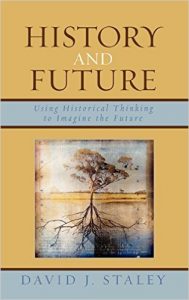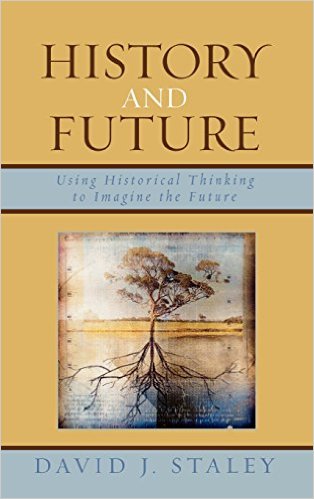 A few weeks ago, we explored a few thoughts around the history of the foresight field. APF colleague Ruben Nelson suggested I look at David Staley’s History and Future: Using Historical Thinking to Imagine the Future. As the title suggests, the goal of this 2007 book was to “apply history-as-method” to the study of the future. In my opinion, it succeeds admirably!
A few weeks ago, we explored a few thoughts around the history of the foresight field. APF colleague Ruben Nelson suggested I look at David Staley’s History and Future: Using Historical Thinking to Imagine the Future. As the title suggests, the goal of this 2007 book was to “apply history-as-method” to the study of the future. In my opinion, it succeeds admirably!
Much of the terrain will be familiar to seasoned futurists, but the story is put together in a useful that I found helped to make and reinforce some connections among the many ideas floating around in my head. [For a sorta rant on novelty, see: Don’t be a nothing new here futurist). For those newer to the field, it provide an excellent conceptual grounding.
The chief argument is comparing a perspective on studying history that aligns marvelously well with scenario thinking. He introduces Michael Stanford’s clever device of distinguish the past as history (history 1) from the narration of the past as history. He observes that historians don’t study the actual past, but rather present evidence that serves as representations of the past. You’re probably thinking that this sounds a lot like what futurists do – we don’t study “the future” but rather ideas or evidence about the future in the present.
The book is nicely written. The author has a knack for providing a sufficient amount of detail to be instructive, but not boring, such as when he reviews the history of futures thinking. He weaves in several important conceptual points; again in a way that balances readability with utility. He raises some excellent points about the use of evidence, the need for disciplined imagination, the role of plausibility in futures thinking, and and that scenarios are better thought of as descriptions of the structure of the future, rather than a process of events.
And he’s backed the idea that historical thinking could be useful in futures by establishing himself as a futurist, and sharing several examples from his own work. I majored in history and political science as an undergrad, and I’ve always been a fan of history and its usefulness in our work. So perhaps it’s no surprise that I liked the book, although I suppose I would have been upset if it had been a hatchet job.
The book closes with some concerns about the job market for historians. Those trained in historical thinking as described by Staley would be a welcome addition to the foresight field! Andy Hines

As a history major turned futurist, the history degree is extremely useful in futures As I tell people who look at me funny when I say I am a historian-trained futurists: Instead of looking at clues from the past and trying to figure out their lives, I look at indicators of the future and try to figure out their lives, It’s the same idea, 180 degrees.
as a fellow history major, “well said,” Christopher!
Andy a nice idea comes from Benedetto Croce when he says “All history is contemporary history” – so all futures are contemporary futures. So the contemporary ie present is as TSEliot suggests where time last and time future collide
Oliver